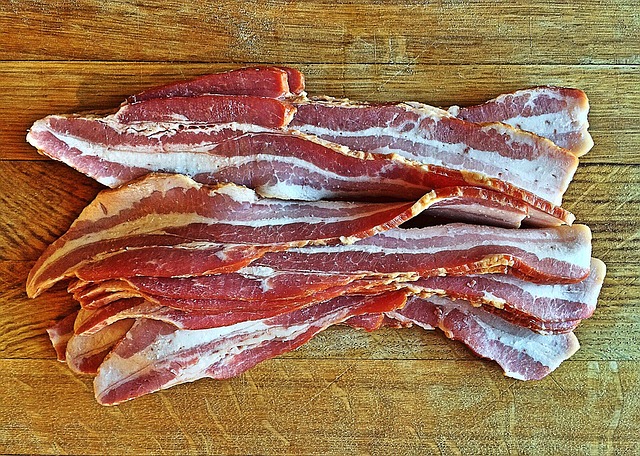
James (an imaginative character) was walking by a restaurant, and his eyes stuck on the menu that was hanging on the wall, saying, Cured and uncured bacon available. “Well, what’s the difference between cured and uncured bacon?” Like many of us, he became confused too. The purpose of this article is to break down this confusion.
Bacon is probably one of the most popular foods for its delicious taste profile and amazing flavor. It is commonly used as an ingredient in fast foods like burgers or sandwiches.
Cured and uncured bacon, two words often confuse foodies. When we say bacon, it naturally represents a cured thin pork cut from the belly or side portion—and preserved for a while, with salt and other ingredients. On the other hand, uncured bacon is a slice of pork, cut from the same parts but preserved in a more natural way.
So, basically, the difference between these two is in the process of preservation. Let us first understand what a cured bacon actually is.
Table of Contents
Comparison chart
| Difference | Cured Bacon | Uncured Bacon |
| Definition | A slice of pork belly or loin preserved with sodium, artificial nitrate, salt, and sugar | A slice of pork belly or loin preserved with natural nitrate sea salt and other natural ingredients. |
| Ingredients | Sodium, artificial nitrate, sea-salt, sugar, and other chemicals. | Nitrates collected from celery, beets, or other vegetables; sea-salt, natural sodium, etc. |
| Nitrate | Synthetically- sourced | Naturally-sourced |
| Flavor | Salty | Much salty compared to cured bacon. |
What is cured bacon?
Curing is a food preserving process. It requires the commercial preparation of several ingredients. This process lets the food last for long by suppressing bacterial growth.

Cured bacon is a thin slice of pork collected from the belly or loin that has been preserved either with a mixture of sodium, artificial nitrates, and salt or with smoke.
Nitrate is a type of chemical compound consisting of nitrogen and oxygen. Manufacturers often use nitrate in order to preserve the food. That is the reason why the bacon looks pink or reddish. This chemical is responsible for restricting the growth of the microbes and helping the food to remain edible.
It is important to understand that nitrates and nitrites are not the same compounds. Nitrates turn into nitrites when they reach our body, and it keeps converting into several other forms over time.
Cured bacon process
Generally, there are two popular ways to process bacon. One is Dry curing. Another one is Wet curing.
Dry curing
Dry curing is a traditional and commonly used technique to preserve meat. During this process, the pork is rubbed with nitrates, salts, and sometimes even with sugar. Then the pork is left for a weak or two. After being cured, the pork is rinsed off and placed in a smoker to add an extra flavor. Because this curing process primarily does not need any liquid hence, it’s called dry curing.
Wet curing
Wet curing is a popular method for commercial usage. This is because it takes less time to process than dry curing. Commercial ingredients like nitrate, salt, seasoning, sugar, and some other chemicals are amalgamated to create a brine during this process.
Then the pork is either soaked in or injected with the brine and kept for a few hours to a couple of weeks. This injection of brine is known as the pumping process. Similar to the dry bacon method, the cured bacon is placed in a smoker machine to increase the flavor.
What is Uncured bacon?
An argument often raises that there is nothing like uncured bacon. As because all bacon has to be cured, it is common to conceive such a conception.

Well, to be clear, the difference between cured and uncured bacon is not seen not from the standpoint of processed and not processed but from the way of processing.
Uncured bacon is a type of cured bacon processed with natural ingredients. Hence, uncured bacon is considered much better and delicious for its consumers. The core element that distinguishes a cured bacon from uncured bacon is artificial nitrate. Basically, bacon that is not processed using artificial nitrate or other chemical compounds is called uncured bacon.
Uncured bacon process
Uncured bacon processing requires ingredients like natural nitrate that is collected from celery/beets/other vegetables, fresh sea salt, seasonings, etc. When all these artificial chemical-free ingredients are mixed with the pork, they create delicious uncured bacon. To add more flavor, uncured bacon is placed in the smoker as well.
Since any synthetically-sourced chemicals are not used in uncured bacon, consumers prefer this type of processed pork as it has the least chance to harm the human body.
The key differences between Cured and Uncured Bacon
- Cured bacon is a slice of pork belly or side part, preserved with artificial nitrate, salt, sugar, sodium, etc. On the other hand, uncured bacon is a slice of pork belly or side, treated with ingredients collected from different natural sources in order to preserve.
- Key ingredients to cure bacon are sodium, salt, artificial nitrate, etc. In contrast, some ingredients to treat uncured bacon are nitrates collected from celery, beet, or other vegetable sources, sea salts, and other natural ingredients.
- Cured bacon takes much time to process. On the contrary, uncured bacon can be processed in less time compared to cured bacon.
- The nitrates that are used in cured bacon are artificially created. The nitrates that are used in uncured bacon are naturally-sourced.
- Uncured bacon tastes much saltier than cured bacon.
Cured vs Uncured bacon: Texture and taste
When it comes to texture and taste, the difference between these two kinds of bacon is not significant. Apart from the source, both kinds of bacon basically have the same sort of ingredients. As a result, it is not easy to differentiate the taste between cured and uncured bacon.
However, because the uncured bacon requires natural sources like sea-salt or celery nitrate to process, the consumers often find this bacon saltier than the cured bacon. Texture Wise, there is a much higher water content in uncured bacon.
Frequently asked questions (FAQs):
Is uncured meat safe to eat?
Since cured and uncured bacon contains high fat and calories, both can be harmful to human health if not consumed is a decent limit. However, this is because the ingredients used to process the uncured bacon are natural. Hence they are less harmful to eat compared to cured bacon.
How long does uncured bacon last?
If the bacon is unopened, it can last up to two weeks in the refrigerator and several months in the freezer. But, if the bacon is left open without being cooked, it won’t last more than a week.
What is dry cured bacon?
Dry-cured bacon is a bacon that is cured in the dry-cured process. A dry cure processing doesn’t require any liquid ingredient.
What is the healthiest bacon to eat?
Uncured bacon is healthier to eat than the cured bacon.
Can you eat uncured bacon raw?
It’s not safe to eat raw, uncured bacon. It can make one sick caused by food poisoning.
Conclusion
Bacon is processed pork that can be either cured or uncured. The core difference between cured and uncured bacon is in the method of processing. While the cured bacon needs artificial elements more to process, the uncured bacon requires ingredients collected from natural sources.

Craig is a full-time academic and research-based article writer from California. A trained content creator who started his career as a column writer for local magazines and newspapers. His works have been published on many renowned online platforms.
